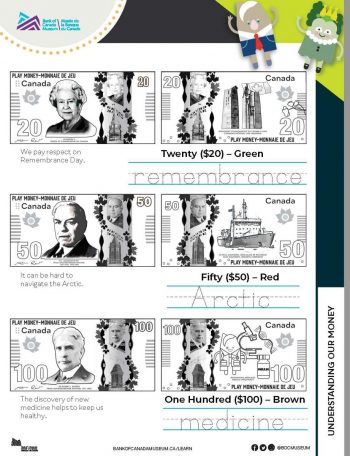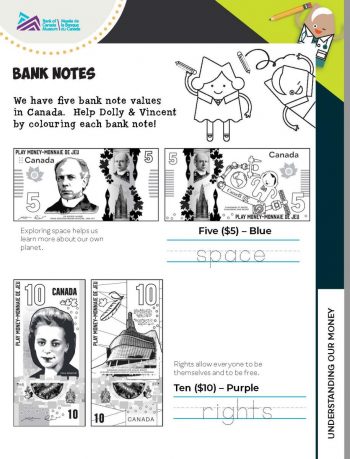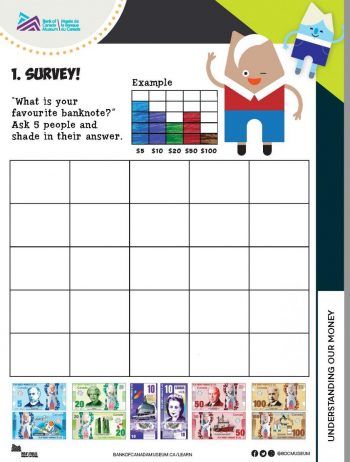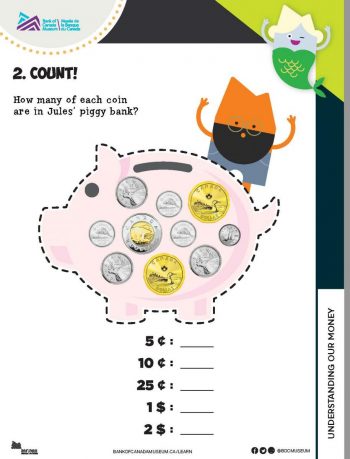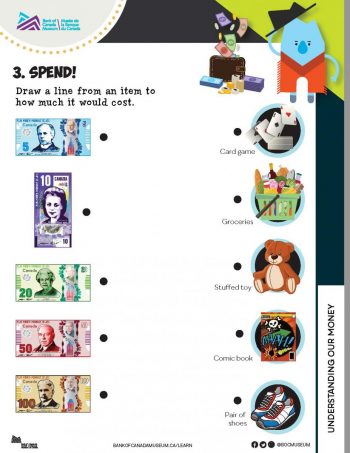
Explore Canadian money with young learners using our printable worksheets.
Overview
Big idea
Canadian money shows us not only the different denominations of coins and bank notes, but also different images of Canadian heritage.
Total time
50 minutes
Grade levels
Kindergarten to Grade 1
Subject areas
Math
- financial literacy: comparing the value of bank notes and coins
- using data: setting up a question of interest, creating bar graphs, drawing conclusions
- arithmetic: natural numbers—representation, comparison, counting, addition
Social studies
- cultural references: history, heritage, symbolism and representation of Canada
- social context: trading and money’s uses and role in the economy
Learning objectives
Students will:
- recognize the different names and denominations of Canadian coins
- recognize the different colours and denominations of Canadian bank notes
- identify the value of a combination of coins or bank notes
Materials
Classroom supplies and technology
- pencils
- colouring supplies, such as crayons, markers or coloured pencils
- computer with internet access and a screen or projector (optional)
- printer
- white board and markers
Worksheet
- Download the worksheet.
- Print one copy of the worksheet for each student.
Activity 1: Learn about Canadian money
Begin the class with a discussion about money and the coins and bank notes we use.
Time
10 minutes
1.1 Opening discussion
Ask your students a few questions before beginning the worksheet:
- What is money?
- What is the largest amount on one bank note (or bill) in Canada? What is the smallest amount on a coin?
- How many different coins and bank notes do we have in Canada? How much are each coin and bank note worth (known as its denomination)?
- What is the name of each coin?
- What images have you seen on coins and bank notes? (Write a list of images on the board.)
Activity 2: Practice activities and colouring
Explore each bank note and coin on the worksheet.
Time
35 minutes
2.1 Identifying coins and bank notes
Introduce the worksheet and hand it out to the class. Explore one coin or bank note at a time. Ask your students the following questions:
- Can you name the different animals or objects on the bank note or coin?
- What about the people featured on the bank notes? Can you name any of the people on them? If not, can you guess what types of people they were (for example prime ministers, royalty trailblazers)?
- What qualities would make someone a good choice to feature on a bank note?
- What are some words to describe the theme of each bank note?
- Have you seen any special coins or bank notes before? What did they have on them?
If you have time, go over each of the questions and explore the students’ answers a bit more. Ask your students to first look at the imagery and then guess a theme from the objects or animals on each coin and bank note.
Ask the students to colour each bank note on the sheet in blue, purple, green, red or brown. You can ask them to take out only these colours to see if they are listening!
Trace the key words that describe the theme of each bank note. If you have time, go over each of the sentences and explore the definitions.
Exploring coins and bank notes activity worksheet.
2.2 Review exercises
At the end of the worksheet you will find a series of activities. Work through each activity with your students. This includes surveying classmates on their favourite bank note, counting coins and matching money to an item. You may want students to pair up for some of the activities.
Exploring coins and bank notes worksheet for colouring.
Conclusion
Check for understanding and close the lesson.
Time
5 minutes
Discussion
Review with your students what they learned today. Can they name each of the coins? Do they remember the colour of each denomination of bank note without looking?
Key takeaways
- Different denominations of coins and bank notes represent different amounts of money.
- Recognizing the different sizes, textures and colours of money helps you make better choices about buying and saving your money.
- Our money displays symbols and people that are important to Canadian history.
Extensions
- Print out a class set of our play money to use in role play and addition and subtraction activities.
- Ask your students to bring in a special coin from home.
- Share Michael Mitchell’s “Canada In My Pocket” song and learn the lyrics together.
- Share our FAQ to help your class discussion or for background information.
- Designing and making the money you hold in your hand today takes a lot of work. Watch a video to explore the life cycle of a banknote or coin production.
- Explore more of the designs and symbols on each bank note on the websites of the first polymer series and the new vertical $10 bill featuring Viola Desmond.
We want to hear from you
Comment or suggestion? Fill out this form.
Questions? Send us an email.

